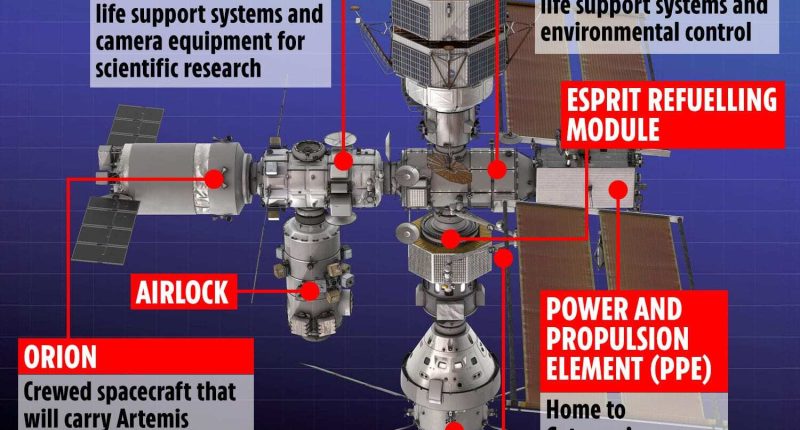NASA’S lunar Gateway – dubbed a ‘shortcut to Mars’ – could house Artemis 4 astronauts as early as 2028, according to current estimates.
It will be humanity’s first extraterrestrial space station, and a massive step in exploring the solar system we call home.
Gateway will provide a base for astronauts to easily access and roam the lunar surface, thanks to its highly-elliptical orbit around the Moon.
This type of orbit will bring it relatively close to the Moon’s surface and far enough away to easily pick up astronauts and supplies from Earth.
According to Nasa, the lunar space station – a fifth of the size of the International Space Station – will be integral to future missions to Mars.
It will act as a practical test of the technologies needed to sustain a human presence in deep space, and chart a path to Mars – journey that can take roughly seven months to complete.
READ MORE ABOUT NASA
“Nasa is building the infrastructure to expand human exploration further out into the solar system than ever before, including Gateway, the lunar space station that will help us make inspirational scientific discoveries at and around the Moon,” Nasa Administrator Bill Nelson said in a statement in July 2021.
“Just as importantly, these investments will help NASA carry out the United States’ horizon goal: to further develop and test the technology and science needed for a human trip to Mars.”
Nasa is working with other space agencies, such as ESA, to build the habitation modules of the spacecraft that Artemis astronauts will call home.
There will be two modules to support astronauts living and working above the Moon’s surface – one called HALO and another known as I-HAB.
Most read in Tech
HALO falls under Nasa’s wing, whereas the ESA will be managing the construction of I-HAB.
HALO
American aerospace firm Northrop Grumman Innovation Systems snagged the $935million (£741million) Nasa contract to build HALO.
The pressurised living quarters will provide command and control systems for visiting crew and spacecraft, such as Nasa’s Orion module, lunar landers, and logistics resupply crafts.
HALO is the core module of the Gateway, and will be extremely barebones.
It’s expected to be a far cry away from the luxuries enjoyed by space tourists, and will be just good enough to sustain four humans at the minimum level for up to 30 days.
The module was initially hoped to launch on a SpaceX Falcon Heavy rocket in November next year.
However, that plan has since been pushed back to no sooner than 2025.
I-HAB
Now, the little-discussed I-HAB module is also devoted to human habitation and life support.
But what sets it apart is that it will contain some closed-loop life support capabilities, as well as offer the ability to explore sustainability in deep space.
The ESA awarded Thales Alenia Space company, and a consortium of other firms, the £295million ($370million) building contract for I-HAB.
I-HAB will have room for four astronauts to comfortably move around, and include protection against micrometeorite impacts.
It is possible that I-HAB will one day contain an astroculture component to supply fresh food for long duration missions – like those to Mars.
Power and Propulsion Element (PPE)
The Power and Propulsion Element (PPE) is what gives the entire space station power.
Without it, there would be no communications; altitude control; orbital control or transfer capabilities on Gateway.
The PPE system uses technology advancements that were realised in last year’s DART mission – where Nasa successfully redirected an asteroid’s path by slamming a rocket into it.
Read more on The Sun
It will make the lunar outpost the most powerful solar electric spacecraft ever flown – even though it generates just 60kW of electrical power.
That is roughly the same amount of power used by a small family car.
Find out more about science
Want to know more about the weird and wonderful world of science? From the Moon to the human body, we have you covered…









